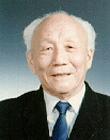

Qian Lingxi(1916-2009) was a native of Wuxi, Jiangsu Province. Qian was an engineering dynamicist. He graduated from Shanghai State-run Sino-French High School in 1936. Qian obtained a superior engineering degree from Brussels Freedom University of Belgium in 1938. After returning to China from his studies in Belgium, Qian taught at Department of Civil Engineering of Yunnan University and Zhejiang University. Since 1952, he has served in several positions with the Dalian University of Science and Technology: a professor, faculty director, superintendent of research institute, and president. He was elected as academician of the Chinese Academy of Sciences in 1955.
Qian had long taken up scientific research related to mechanics. His academic contributions include achievements in structural mechanics, board shell theory, limit analysis, variation principles, and structural optimized design. When the application power of computers became better known, Qian created a computing mechanics discipline and established a computing mechanics team at Dalian University of Science and Technology. In middle 1940s, Qian discovered a simplified method of analyzing suspension bridge which was highly recognized by American Society of Civil Engineers (ASCE). He pioneered in study on variation principle among Chinese dynamicists. In 1950, he published a thesis named On Complementary Energy Principle in China Science, in which he proved complementary energy can be a powerful energy variation principle for non-linear problem. In 1951 and 1952, he published two textbooks for university teaching: Statically Indeterminate Structures and Statically determinate Structures. Qian also discovered crown cantilever method to calculate arch dam, which considered twisting action of arch dam body. He also put forward a new type of buttress dam: terraced dam, which is more economic and easy to abstract heat. From the perspective of engineering, Qian always focused his attention on the ultimate bearing capacity of structures in a given load. He had long been engaged in limit analysis and proposed a generalized variational principle for the limit analysis in solid mechanics in 1965, which attracted wide attention in dynamic field. In 1970s, he initiated computational dynamics and proposed research on theory and method of optimum design of structures. In 1983, he published a thesis in the name of "Sequence Quadratic Programming (SQP) of Optimum Design of Engineering Structures", which provided a practical program of optimizing the structures. In recognition of his contributions in optimum design of structures, he was given State Education Commission Science and Technology Progress Award, First Class in 1990 and State Natural Science Prize, Second Class in 1991. He was also given Ho Leung Ho Lee Award for Science and Technology in physics in 1995.